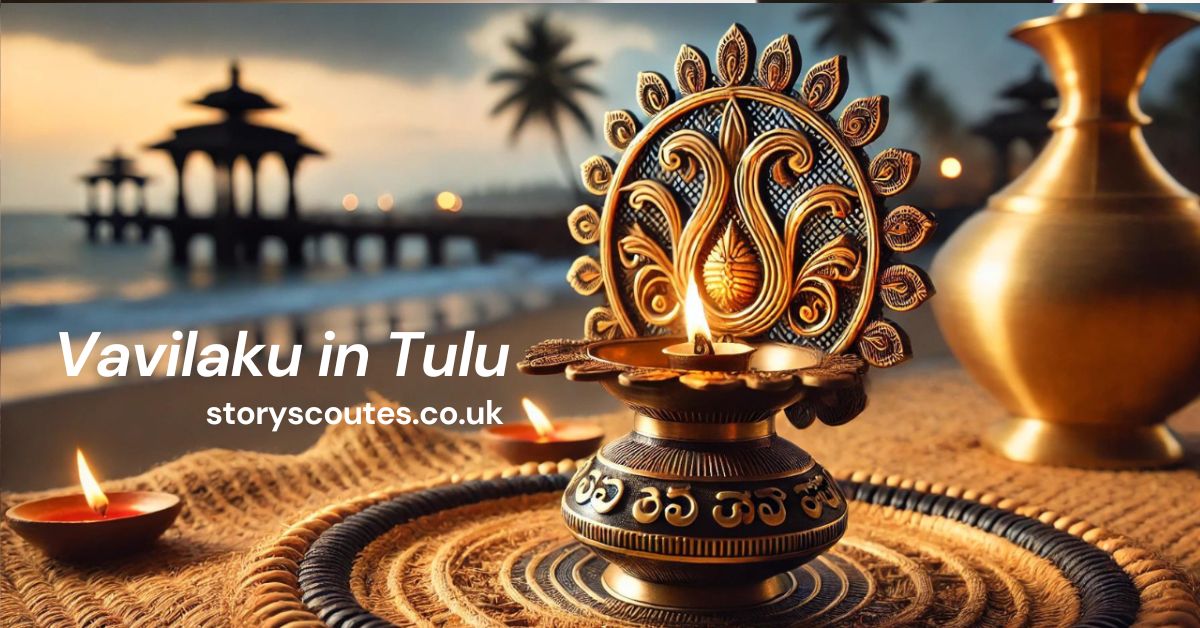Vavilaku in Tulu: Illuminating Tradition and Culture
Vavilaku in Tulu is more than just a lamp; it symbolizes light, hope, and good fortune in the Tulu community. Originating from the southwestern part of India, particularly in Karnataka, the Tulu culture is rich with traditions, festivals, and rituals that celebrate life and spirituality. The vavilaku, made of clay, holds a special place during festivals and ceremonies, casting its warm glow on significant moments in people’s lives.
In the Tulu language, “vavilaku” translates to “lamp” or “light.” This lamp is not merely a functional object; it represents a connection to the divine and the community’s values. The flickering flame serves as a reminder of the light of knowledge, purity, and the triumph of good over evil. Through this article, we will explore the significance of vavilaku in Tulu, delving into its history, cultural importance, and the various ways it is used in Tulu traditions and rituals. We will also address common questions about vavilaku to provide a deeper understanding of this beautiful cultural artifact.
The Origin of Vavilaku in Tulu Culture
Historical Significance
The tradition of using lamps can be traced back centuries in Indian culture. In Tulu culture, the vavilaku is believed to have ancient roots, symbolizing the triumph of light over darkness. This lamp is often crafted from clay, molded by skilled artisans who pay attention to detail, ensuring each piece is unique.
The use of lamps dates back to Vedic times, where they were used in various rituals and ceremonies. In Tulu culture, lighting the vavilaku is seen as an offering to the deities, inviting blessings and positive energy into homes and communities. The soft flicker of the flame is believed to carry prayers to the heavens, making it a vital element in Tulu spirituality.
In ancient Tulu, homes were often adorned with multiple vavilakus during festivals, creating a mesmerizing display of light that symbolized hope and joy. This tradition has been passed down through generations, making vavilaku an essential part of Tulu identity.
The Role of Vavilaku in Spiritual Practices
In Tulu households, the lighting of vavilaku is not just a ritual but a spiritual practice that reflects the community’s connection to their heritage. The act of lighting the lamp is often accompanied by prayers and chants, which are believed to invite divine blessings into the home.
Families place the vavilaku on the altar during poojas (prayer rituals) and offer flowers, fruits, and sweets as offerings. This practice reinforces the belief that light represents purity and divine presence. The flame’s glow is thought to ward off negative energies and bring prosperity and happiness to the household.
Craftsmanship of Vavilaku
Materials and Design
Vavilaku is typically made from clay, which is abundant in the region. The process of creating a vavilaku involves several steps:
- Molding: Artisans shape the clay into intricate designs. Traditional vavilakus often feature floral and geometric patterns, symbolizing nature and harmony. The craftsmanship reflects the rich cultural heritage of the Tulu community, where each design tells a story.
- Drying: Once molded, the clay is left to dry, ensuring it becomes hard and durable. This drying process is crucial, as it prepares the lamp for the firing stage.
- Firing: The dried clay is then fired in a kiln, making the vavilaku sturdy and ready for use. This process also enhances the color and texture of the clay, giving the lamp its distinctive look.
- Painting: Some artisans adorn the vavilaku with colorful paints or glazes, adding to its aesthetic appeal. These vibrant designs not only enhance the lamp’s beauty but also reflect the joyous spirit of Tulu festivals.
Symbolism in Design
The designs on the vavilaku hold significance. For example, flowers represent beauty and life, while geometric shapes symbolize stability and balance. Each detail tells a story, reflecting the beliefs and values of Tulu culture. The vavilaku’s design can vary depending on the occasion, with specific motifs chosen for festivals and rituals.
Artisans often create special vavilakus for significant events, such as weddings and housewarming ceremonies. These lamps may feature intricate carvings and unique shapes, showcasing the skill and creativity of the craftsmen.
The Role of Artisans
The art of crafting vavilaku is typically passed down through generations, with families often engaging in this traditional craft. Many artisans have honed their skills over the years, ensuring that each vavilaku is a work of art.
Women, in particular, play a significant role in this craft. They are often involved in the molding and painting processes, bringing their creativity and artistry to the vavilaku. This practice not only empowers women in the community but also helps preserve traditional craftsmanship, ensuring that the art of vavilaku-making continues for future generations.
Vavilaku in Tulu Traditions and Rituals
Festivals Celebrating Vavilaku
Vavilaku plays a central role in various Tulu festivals. Here are a few prominent occasions where vavilaku is indispensable:
- Diwali: Known as the festival of lights, Diwali is celebrated with great enthusiasm in Tulu households. Families light vavilakus to symbolize the victory of light over darkness and good over evil. The warm glow of the lamps brings joy and togetherness. Homes are decorated with rangoli (colorful patterns made with colored powders) and illuminated with vavilakus, creating a festive atmosphere.
- Sankranti: This harvest festival is marked by the lighting of vavilakus in homes. It signifies gratitude for the bountiful harvest and invites prosperity for the coming year. Families prepare traditional dishes and share them with neighbors, fostering a sense of community and togetherness. The lighting of vavilakus during Sankranti is accompanied by prayers for a prosperous harvest in the future.
- Brahma Muhurta: Many Tulu families light vavilaku early in the morning during this auspicious time, which is believed to enhance spiritual energy and promote positive beginnings. This practice is often accompanied by meditation and prayers, setting a positive tone for the day ahead.
Ceremonies Involving Vavilaku
Apart from festivals, vavilaku is integral to many rituals and ceremonies, such as:
- Weddings: During Tulu weddings, vavilaku is lit to invoke blessings from ancestors and deities, ensuring a prosperous and harmonious union. The vavilaku is often placed at the wedding altar, creating a sacred space for the couple to exchange vows. Lighting the vavilaku during the ceremony is a symbolic act of welcoming light and positivity into the couple’s new life together.
- Poojas (Prayers): The vavilaku is placed on the altar during poojas, symbolizing the presence of divine energy and the light of knowledge. Families gather around the vavilaku, reciting prayers and offering flowers and fruits. This practice reinforces the belief that the light of the vavilaku purifies the space and invites divine blessings.
- Housewarming Ceremonies: When a new home is blessed, vavilaku is lit to bring prosperity and happiness to the inhabitants. The lighting of the lamp during this ceremony symbolizes the removal of darkness and the welcoming of positive energies into the new space.
Everyday Use of Vavilaku
In addition to its role in festivals and ceremonies, vavilaku is also used in daily life. Many Tulu families light vavilakus during evening prayers, creating a peaceful and spiritual atmosphere in their homes. The soft glow of the lamp serves as a reminder of their values and beliefs, encouraging family members to reflect on their actions and intentions.
Vavilakus are sometimes placed in gardens or courtyards, where they illuminate the surroundings and create a warm, inviting space. This practice fosters a sense of community, as neighbors may gather to share stories and celebrate life under the soft glow of the vavilaku.
The Cultural Significance of Vavilaku in Tulu Society
Light as a Symbol of Hope
In Tulu culture, light represents hope and positivity. The act of lighting a vavilaku is a metaphor for overcoming challenges and embracing new beginnings. It serves as a reminder to stay hopeful, even during difficult times. Families often gather around the vavilaku, sharing stories and experiences, reinforcing their bonds and collective hopes for the future.
Community Bonding
Vavilaku also fosters a sense of community among Tulu people. Families often gather during festivals and rituals, sharing stories and experiences while lighting vavilakus together. This practice strengthens bonds and promotes unity, reflecting the communal spirit of Tulu culture.
Lighting vavilakus during festivals and ceremonies creates a shared experience among community members. Neighbors come together to celebrate, reinforcing their connections and fostering a sense of belonging. This sense of community is especially important in Tulu culture, where relationships and social bonds are highly valued.
Preservation of Heritage
As Tulu culture continues to evolve, the vavilaku remains a vital link to the past. Efforts to preserve traditional crafts and customs surrounding vavilaku contribute to the sustainability of Tulu heritage. Local artisans play a crucial role in this preservation, passing down their skills to future generations.
In recent years, there has been a resurgence of interest in traditional crafts, including vavilaku-making. Artisans are now showcasing their work at cultural fairs and festivals, raising awareness about the importance of preserving these traditions. This revitalization helps ensure that the art of crafting vavilaku continues to thrive, providing a sense of identity for the Tulu community.
Educational Role of Vavilaku
The vavilaku also serves an educational purpose within the Tulu community. Through the tradition of lighting vavilaku during festivals and rituals, younger generations learn about their cultural heritage and values. Families often share stories about the significance of the lamp, imparting lessons about hope, perseverance, and community.
Parents and elders encourage children to participate in lighting the vavilaku, fostering a sense of responsibility and connection to their roots. This practice not only preserves tradition but also instills a sense of pride and identity in the younger generation.
Modern Adaptations of Vavilaku
Contemporary Designs
As times change, so do the designs and styles of vavilakus. Contemporary artisans are experimenting with new materials and aesthetics, creating modern interpretations of this traditional lamp. While the essence of vavilaku remains the same, these adaptations reflect the evolving tastes and preferences of the younger generation.
Some artisans are incorporating sustainable materials, such as recycled clay and eco-friendly paints, into their designs. This approach not only promotes environmental consciousness but also appeals to consumers who prioritize sustainability in their purchases.
Impact of Globalization
Globalization has influenced the way vavilakus are perceived and used. With increased access to the internet and social media, Tulu artisans are now able to showcase their work to a global audience. This exposure has led to a growing interest in Tulu culture and crafts, encouraging more people to appreciate and support traditional art forms.
Artisans are now collaborating with designers and brands, creating unique products that blend traditional craftsmanship with contemporary aesthetics. This collaboration helps bridge the gap between tradition and modernity, ensuring that the vavilaku remains relevant in today’s world.
Challenges Faced by Artisans
Despite the growing interest in vavilaku, artisans face challenges in preserving their craft. The decline in demand for traditional clay lamps due to the rise of electric lighting poses a threat to this age-old practice. Many artisans struggle to make a living solely from vavilaku-making, leading to a loss of skills and knowledge within the community.
Efforts are being made to promote vavilaku and support local artisans through workshops and cultural events. By raising awareness about the significance of vavilaku, these initiatives aim to revive interest in traditional crafts and ensure that artisans can continue their work for generations to come.
Personal Stories and Anecdotes
Family Traditions
In many Tulu families, the lighting of vavilaku is a cherished tradition passed down through generations. For example, Priya, a Tulu woman from a small village in Karnataka, recalls how her grandmother would light a vavilaku every evening before dinner. “It was our way of inviting peace and harmony into our home,” she shares. “We would sit together, share stories, and reflect on our day.”
This practice not only fostered family bonding but also instilled a sense of gratitude and appreciation for the little things in life. Priya continues this tradition with her own children, ensuring that they understand the importance of vavilaku in their heritage.
Community Celebrations
During festivals, the atmosphere in Tulu villages is vibrant and lively, with families lighting vavilakus to celebrate. Many community members come together to participate in celebrations, sharing food, laughter, and joy.
Rajesh, a local artisan, shares his experience of lighting vavilakus during Diwali: “It’s a beautiful sight to see the entire village illuminated with vavilakus. It brings everyone together, creating a sense of unity and joy. We often light a vavilaku at the entrance of our homes to welcome guests and invite positive energy.”
These personal stories highlight the deep-rooted connections between vavilaku, family, and community, showcasing how this tradition enriches the lives of Tulu people.
FAQs About Vavilaku in Tulu
What is vavilaku, and what does it symbolize?
Vavilaku is a traditional lamp made from clay, primarily used in Tulu culture. It symbolizes light, hope, and good fortune, representing the triumph of good over evil. Lighting a vavilaku is often accompanied by prayers and rituals, inviting blessings into homes and communities.
How is vavilaku made?
Vavilaku is crafted from clay, which is molded into intricate designs by artisans. The clay is dried and fired in a kiln, making it sturdy and ready for use. Some vavilakus are adorned with colorful paints or glazes, enhancing their aesthetic appeal.
When is vavilaku used in Tulu culture?
Vavilaku is used during various festivals, such as Diwali and Sankranti, as well as in rituals like weddings and poojas. It is also lit during everyday prayers to create a peaceful atmosphere in homes.
Why is vavilaku significant in Tulu society?
Vavilaku holds cultural and spiritual significance in Tulu society, symbolizing hope and positivity. It fosters community bonding during celebrations and serves as a reminder of the values and traditions passed down through generations.
How can I support traditional vavilaku artisans?
You can support traditional vavilaku artisans by purchasing their crafts directly from local markets or through online platforms that promote sustainable and ethical products. Additionally, participating in cultural events that showcase Tulu crafts can help raise awareness and appreciation for this beautiful art form.
Conclusion
Vavilaku in Tulu is more than just a lamp; it is a symbol of light, hope, and community. Its rich history, craftsmanship, and significance in rituals reflect the essence of Tulu culture. As we explore the various aspects of vavilaku, it becomes evident that this simple clay lamp carries profound meaning, connecting generations and enriching lives.
In a world where traditions often fade, the vavilaku stands as a beacon of hope, reminding us of the importance of preserving our cultural heritage. By supporting artisans and participating in Tulu traditions, we can ensure that the light of vavilaku continues to shine brightly for years to come.






